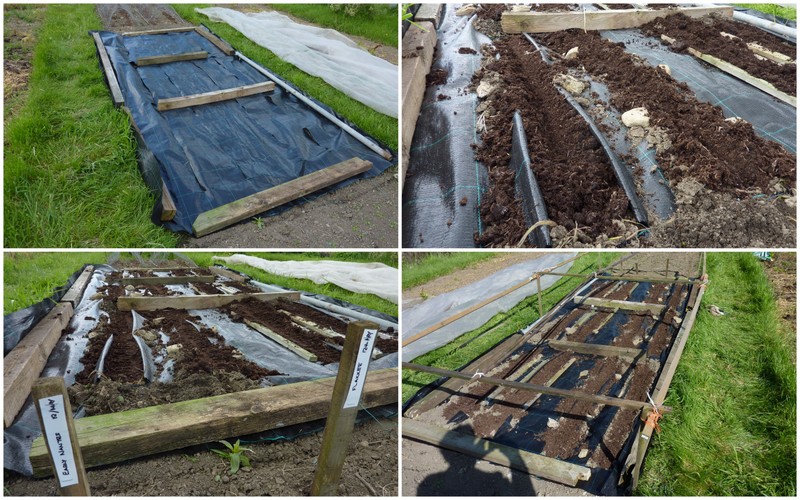




Unfortunately carrot flies thrive in moist and mild climates – just like ours and our countryside provides many wild plants, such as cow parsley, which the carrot fly is attracted to. Problems with carrot fly larvae can discourage gardeners from even trying to grow carrots.
Carrot fly are small black insects, about 5mm long, that feed on nectar. They look a little like an ant with wings. The female lays her eggs in the soil close to where carrots are growing so that when hatched the tiny maggots have a ready food supply. The maggots feed on the root of the carrot and are responsible for the brown tunnels that regularly spoil the carrot crop.
Carrot flies are said to be poor fliers and it is suggested that any open topped barrier that surrounds the carrots will prevent the fly from entering. I must admit to being a bit sceptical about this, it is likely that carrot flies can be carried over the barriers on the wind, so we prefer to completely cover our carrot crop with enviromesh. To be effective the covering needs to be in place before the flies begin to lay their eggs. This tends to be in May but accurate forecasts are produced on the web.
Removing the covering in order to weed the crops can allow some fly in meaning this isn’t a foolproof method.
Carrot flies home in to the smell of the carrots so weeding when there is little breeze on a dry evening can reduce the chances of carrot fly invasion of your carrot beds. After weeding firm down any loosened soil. There is also a suggestion that growing carrots alongside a different strongly scented crop such as onions or garlic can help control the fly. Research does back up that this does have some effect but it is only small and it need four rows of onions to each row of carrots. It is not effective until the onions are making leaf.
To avoid a build up of pests it is essential that you do not grow carrots in the same place in two consecutive years.
Another pest of newly emerging carrot seedlings is the slug so your chosen control of these greedy creatures needs to be in place before the carrot seedlings start to germinate.
Our sowing and growing method

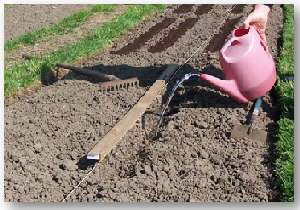
Using a hoe, pull out a shallow trench.
In dry weather water the trench well
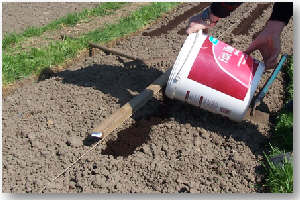
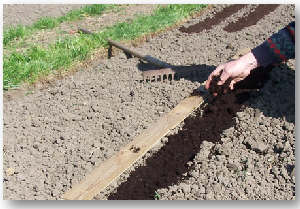
Fill the trench with multi-purpose compost. If the compost is lumpy crumble the lumps so that the compost is of a fine consistency.
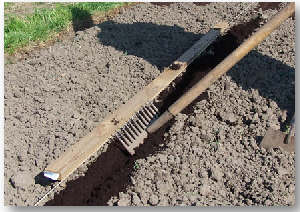
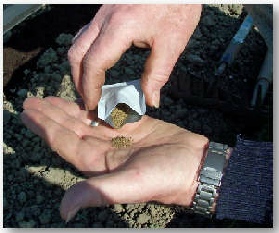
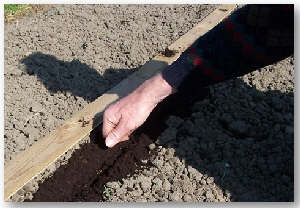
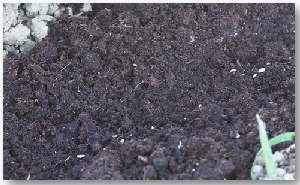
With the back of the rake create a drill.
Pour some seeds onto your hand.
Sprinkle the seeds into the drill. Take care not to sprinkle the seed too thickly to avoid the need for thinning which encourages carrot fly.
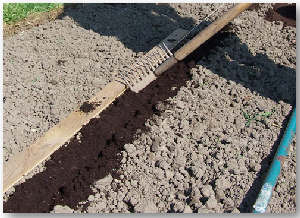
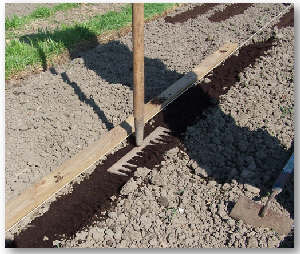
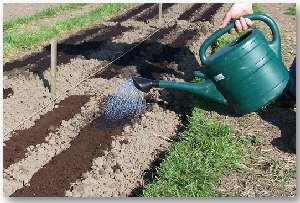
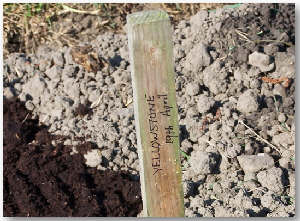
Carefully cover the seed.
Tap down the compost using the back of the rake.
Water the compost well and make sure that the compost is watered regularly to avoid drying out.
Don't forget to label the row. Before covering we use a few slug pellets to try and prevent the slugs form mowing down the newly emerging seedlings. Having the mesh in place means that these do not pose a threat to birds etc.
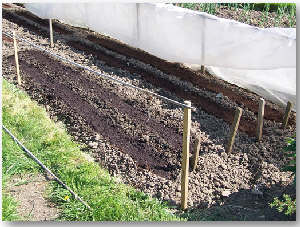
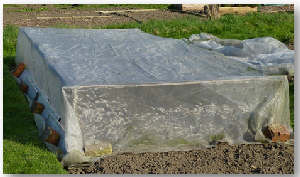
Build a framework around the seed bed. It needs to be high enough to leave in place when the carrots are fully grown. Cover the frame with enviromesh or fleece. Enviromesh is more durable and can be reused each year and air flow around the crop is better than when using fleece. Secure the edges of the covering well to prevent entry by determined carrot flies. The covering needs to be easily removed for weeding or harvesting. Enviromesh or fleece allows water through so can remain in place when watering. NB Sparks floating from nearby bonfire will damage melt/burn hole in the covering.
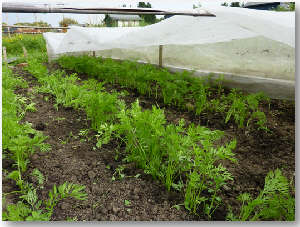
Carrots can cope with weeds more than they can cope with carrot fly. We weed our carrots once whilst they are still fairly small. This gives them a head start in the competition against weeds. If necessary we also weed again if the weeds are causing a problem. You need to keep an eye on what is going on beneath the enviromesh. We chose a fairly still day, preferably in late afternoon and only remove as much enviromesh as necessary in order to get underneath to work. We try to provide as little chance as possible for carrot fly to take this opportunity to access the young carrots.
2010 Carrot Harvest
All the carrots below were harvested in August when the tops were still green and growing so it is likely that the carrot roots will continue to grow for a while more.
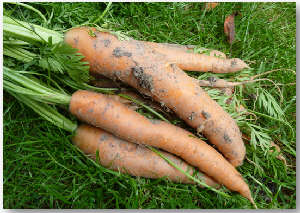
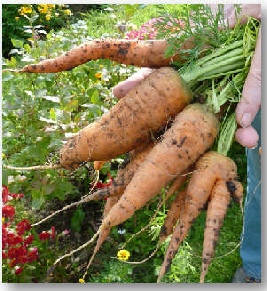
Early Nantes 2
Very little if any slug damage - a dry May and June may have helped.
Flakkee
A bit of forking but the carrots still taste delicious. Little if any slug damage.
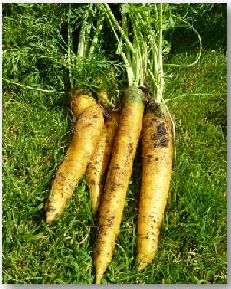
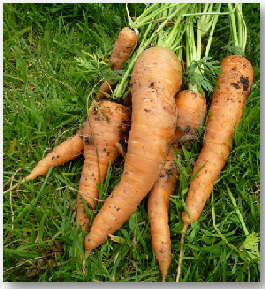
Yellowstone
The green on the shoulders is where the tops of the carrots pushed out of the soil into the light. The rest of the carrot is unaffected and so just trim off the green bits. Little if any slug damage.
Autumn King 2
A little early for harvesting this variety but it had already produced good sized roots. Little if any slug damage.
Does sowing carrots late avoid carrot fly damage?
We read that if carrots were planted late in the season then they didn't suffer from carrot fly damage and so we tried this out. We sowed some Early Nantes carrots in July which germinated well and produced some reasonable looking roots but the tops showed signs that they have been affected by carrot fly.
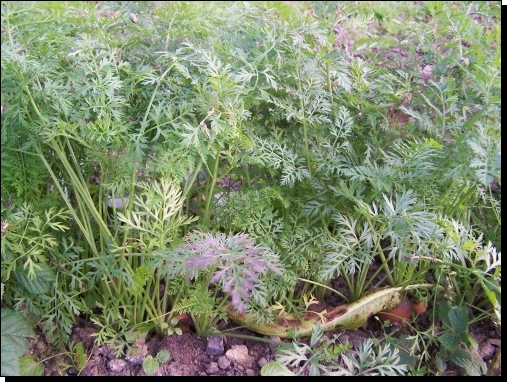
So although the carrots may have been less badly affected this method didn't really work for us
By the way can anyone answer this query. I have read that carrot fly only fly about 50 cm off the ground. If so how do they manage to travel as far as they do without coming across a barrier of some sort?
Winter Protection
Our carrots are left in the ground over winter under a protective layer of straw and harvested as needed. This has worked well for us for several years now. Click here for more details



